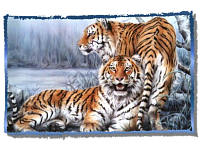 |
| I choose to write about them al well because they are my favorite animal and i think that we should keep on reminding pople that preatty soon they can dissapere! |
| Appearance Eyes: Tigers have round pupils and yellow irises (except for the blue eyes of white tigers). Due to a retinal adaptation that reflects light back to the retina, the night vision of tigers is six times better than that of humans. Claws: Like domestic cats, tiger claws are retractable. Tiger scratches on trees serve as territorial markers. Stripes: No one knows exactly why tigers are striped, but scientists think that the stripes act as camouflage, and help tigers hide from their prey. The Sumatran tiger has the most stripes of all the tiger subspecies, and the Siberian tiger has the fewest stripes. Tiger stripes are like human fingerprints; no two tigers have the same pattern of stripes. Head: The tiger's head often carries the Chinese mark of wang or king on the forehead. Chinese wang mark |
| Tiger with wang mark on forehead Color: Most tigers have an orange coat with dark brown or black stripes accented with white. Tigers that live in cold climates (Siberian tigers) have thicker fur than tigers that live in warm climates. Tail: A tiger's tail is 3 to 4 feet long, about half as long as its body. Tigers use their tails for balance when they run through fast turns. They also use their tails to communicate with other tigers. Paw prints: A tiger's paw prints are called pug marks. Habitat Description: All wild tigers live in Asia. Tigers live in thick forests or areas with tall grasses to hide in and plenty of prey to eat. They don't like open grasslands. Most kinds of tigers live where it is warm but Siberian tigers live where it gets very cold. Size: The size of a tiger's territory depends on how much prey there is to eat. For example, in some parts of India where there is plenty of prey, a male tiger only needs eight to sixty square miles . In Sumatra, where there is less prey, a male tiger may need as much as 150 square miles. And in Siberia, where there is little prey to be found, male tiger territories are as large as 400 square miles. Living Alone: Unlike some big cats like lions, adult tigers like to live alone (except for mother tigers with cubs). This is partly because in the forest, a single tiger can sneak up and surprise its prey better than a group of tigers can Territory: The size of a tiger's territory depends on the amount of food available, and usually ranges from about 10 to 30 square miles (26-78 sq. km). Siberian tigers sometimes have really big territories (as large as 120 square miles). Although tigers usually live alone, tiger territories can overlap. A male tiger's territory usually overlaps those of several female tigers. Scent Marking: Tigers mark their territories by spraying bushes and trees with a special mixture of urine and scent gland secretions. They also leave scratch marks on trees. Eating: Wild tigers can eat as much as 40 pounds of meat at one time. After eating a lot, they often do not eat again for several days. Over much of the tiger's broad geographic range, wild pig, wild cattle and several species of deer are its major prey. Unlike wild tigers which kill their prey and then gorge, tigers that live in zoos eat a prepared diet of horse meat and vitamins daily. They may eat as much as 10 pounds of meat per day. |
 |
| continue... |
| home |
